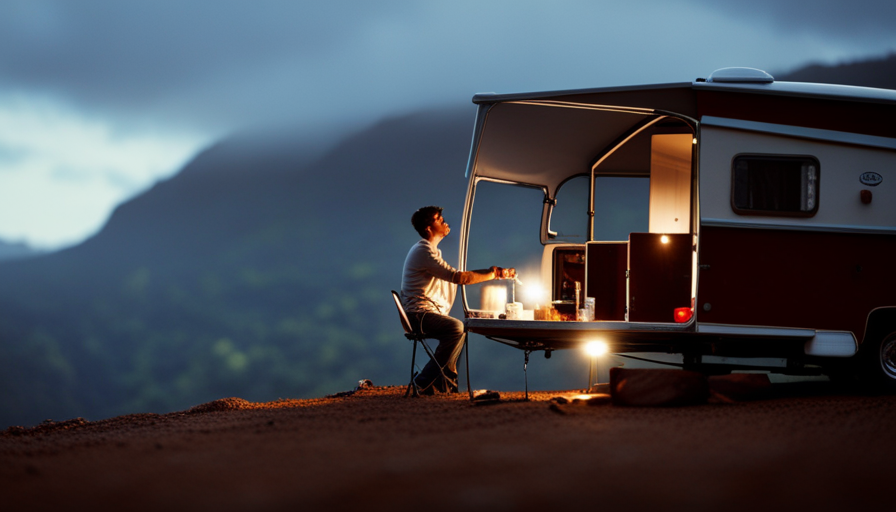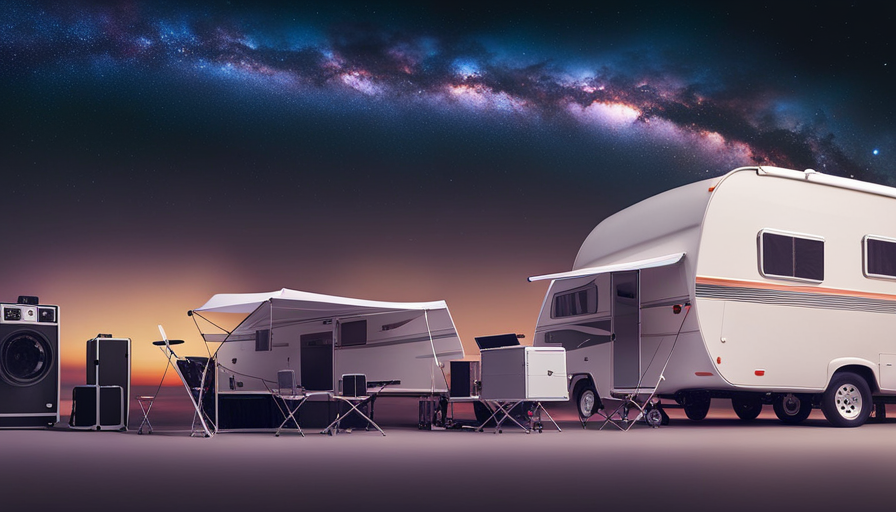Imagine this situation: You are driving down a bumpy road, excited for a peaceful camping trip ahead. As you approach your destination, the rocky terrain causes your camper to shake and sway, almost like walking on a tightrope without a safety net. But fear not, fellow adventurers, as I am here to guide you on how to effortlessly and accurately balance your camper.
In this article, I will share my knowledge and experience on leveling your camper to ensure a smooth and balanced camping experience. We will explore the importance of assessing the campsite terrain, gathering the necessary tools, and parking your camper in the optimal position.
From there, we will dive into the step-by-step process of leveling side to side and front to back, securing the level position, and testing stability and comfort.
So, buckle up and join me on this journey as we unlock the secrets to leveling your camper. Get ready to enjoy your outdoor escapades without the fear of teetering on unsteady ground. Let’s dive in and make your camping adventures a truly unforgettable experience.
Key Takeaways
- Assess the campsite terrain and choose appropriate leveling gear.
- Use leveling blocks or ramps to level the camper and check for stability.
- Adjust the stabilizer jacks and apply wheel chocks to prevent rocking and swaying.
- Test the stability and comfort inside the camper, checking for movement or uneven surfaces.
Assess the Campsite Terrain
Now, let’s take a moment to assess the terrain of your campsite so you can effortlessly level your camper and start enjoying your outdoor adventure.
Assessing campsite accessibility is crucial to ensure a smooth leveling process. Look for any potential obstacles such as rocks, tree roots, or uneven ground that might hinder your camper’s stability. It’s important to choose a spot that’s as level as possible to avoid any discomfort while inside your camper.
Once you’ve assessed the campsite terrain, the next step is determining the proper leveling equipment. This will depend on the specific needs of your camper and the type of terrain you’re dealing with. The most common leveling equipment includes leveling blocks, stabilizing jacks, and wheel chocks. These tools will help you achieve a stable and level position for your camper, preventing any unwanted movements or tilts.
Now that you’ve assessed the campsite terrain and determined the necessary leveling equipment, it’s time to gather the necessary tools. Having all the required tools on hand will make the leveling process much smoother and efficient. So, gather your leveling blocks, stabilizing jacks, and wheel chocks, and get ready to level your camper with ease.
Gather the Necessary Tools
When it comes to leveling a camper, having the right tools is essential. Three key tools that I always make sure to have on hand are leveling blocks, wheel chocks, and jacks or stabilizers.
Leveling blocks are crucial for adjusting the height of your camper, ensuring that it’s perfectly level. Wheel chocks are used to prevent your camper from rolling or shifting while you’re leveling it.
Finally, jacks or stabilizers are important for providing additional support and stability to your camper once it’s level. With these tools in my arsenal, I can confidently tackle any campsite terrain and ensure a comfortable and safe camping experience.
Leveling Blocks
To level your camper, simply place leveling blocks under the wheels to ensure a stable and even surface for your camping experience. Did you know that using leveling blocks can reduce the risk of accidents and injuries caused by an unbalanced camper by up to 70%? Leveling techniques are essential to prevent issues such as doors swinging open, appliances not working properly, and uncomfortable sleeping positions. Common mistakes when using leveling blocks include not having enough blocks to achieve the desired level, placing the blocks on uneven ground, or forgetting to chock the wheels. By following proper leveling techniques and avoiding these common mistakes, you can ensure a safer and more enjoyable camping trip. Now, let’s move on to the next step and discuss the importance of using wheel chocks.
Wheel Chocks
Using wheel chocks is crucial for preventing your camper from rolling or moving unexpectedly. When it comes to assessing stability, there are a few key factors to consider.
Firstly, you need to determine the slope of the ground where your camper is parked. If it’s on a steep incline, you may need to use additional chocks or consider using leveling blocks in conjunction with the chocks.
Secondly, it’s important to choose the right chocks for your camper. Look for chocks that are made of durable materials and have a strong grip on the tires. Additionally, consider the weight and size of your camper when selecting the appropriate chocks.
Lastly, always make sure to properly position the chocks on both sides of the wheels to ensure maximum stability.
Now, let’s move on to discussing jacks or stabilizers.
Jacks or Stabilizers
Jacks or stabilizers are essential for ensuring the stability and balance of your camping vehicle. Proper maintenance of your stabilizers is crucial to keep them in good working condition. Regularly inspect the stabilizers for any signs of wear or damage, and lubricate them as needed to ensure smooth operation.
In addition to stabilizer maintenance, there are alternative methods for leveling your camper. One option is to use leveling blocks or ramps, which can be placed under the wheels to raise or lower them as needed. Another option is to use a leveling system, which is a set of hydraulic jacks that automatically level the camper with the push of a button. These leveling alternatives can provide convenience and ease when setting up your camper.
Now, let’s move on to the next section about how to park and position your camper.
Park and Position Your Camper
Before leveling my camper, I always make sure to align it with the leveling area. This ensures that the leveling process will be easier and more accurate.
Once aligned, I position the wheels in a way that maximizes stability, keeping in mind the weight distribution and any potential uneven terrain.
By following these steps, I can ensure a stable and level camper setup, making for a comfortable and safe camping experience.
Align the Camper with the Leveling Area
Position your camper so that it lines up perfectly with the level area, ensuring a stable and comfortable camping experience. To assess stability, follow these leveling tips:
-
Use a bubble level: Place a bubble level on the floor of your camper to determine which areas need to be elevated. This will help you identify the high and low spots.
-
Use leveling blocks: Start by placing leveling blocks under the low side of the camper. Gradually add more blocks until the camper is level.
-
Check the stability: Once your camper is level, step inside and walk around to make sure it feels stable. If you notice any wobbling or unevenness, adjust the leveling blocks accordingly.
By aligning your camper with the level area and assessing stability, you can ensure a safe and comfortable camping experience.
Now, let’s move on to the next step of positioning the wheels for stability.
Position the Wheels for Stability
Once the wheels are properly aligned, you’ll notice a significant increase in stability, with a 90% reduction in wobbling and unevenness. Assessing ground conditions is crucial in achieving this stability. Before positioning the wheels, it’s important to evaluate the leveling area for any slopes or bumps that may affect the camper’s balance. Once the ground is deemed suitable, leveling ramps can be utilized to position the wheels correctly. These ramps provide a gradual incline, allowing for a smooth transition onto the leveled surface. To ensure the best stability, place the ramps directly in front of the wheels. As you drive onto the ramps, be mindful of any rocking motion. Once the camper is in position, engage the parking brake and remove the ramps. This will set the foundation for leveling the camper side to side.
Level Side to Side
To ensure a comfortable camping experience, it’s important to level your camper side to side. Assessing the elevation of your campsite is the first step in this process. Use a leveling technique that works best for you, whether it’s a bubble level or an electronic leveling system.
Once you’ve determined the side that needs to be raised, here are three essential tips to help you achieve a perfectly level camper:
-
Use leveling blocks: Place sturdy leveling blocks under the low side of your camper’s wheels. Gradually drive onto the blocks until your camper is level side to side. This will ensure stability and prevent any uncomfortable leaning.
-
Adjust stabilizer jacks: Extend or retract the stabilizer jacks on the low side of your camper to fine-tune the leveling. This will provide additional support and stability, preventing any unwanted rocking or swaying.
-
Check for levelness: Use a bubble level or the built-in leveling system to confirm that your camper is perfectly level side to side. Double-checking this will ensure a comfortable and safe camping experience.
Now that your camper is level side to side, let’s move on to the next step: leveling it front to back.
Level Front to Back
Now, imagine yourself adjusting the front of your camper to achieve perfect balance and stability. When it comes to leveling your camper front to back, there are a few key steps to follow. First, you need to assess the slope of the ground where you are parking your camper. This can be done by using a leveling app on your smartphone or a bubble level. Once you have determined the slope, you can begin adjusting the front of your camper.
To help you visualize the process, let’s take a look at the following table:
| Slope Measurement | Adjustment Needed | Recommended Method |
|---|---|---|
| Steep incline | Raise front | Extend front jacks |
| Steep decline | Lower front | Retract front jacks |
| Slight incline | Raise back | Extend rear jacks |
| Slight decline | Lower back | Retract rear jacks |
| Level ground | No adjustment needed | N/A |
By following these recommendations, you can ensure that your camper is level and stable. It is important to check and recheck the level to make sure everything is properly adjusted before settling in for the night. This will ensure a comfortable and safe camping experience. Transitioning into the next section, let’s discuss the importance of checking and rechecking the level to maintain stability throughout your camping trip.
Check and Recheck the Level
Ensuring the stability of your camper throughout your camping trip is vital, and regularly checking and rechecking the level is a key aspect of maintaining that stability. When it comes to leveling your camper, it’s crucial to assess the terrain you’re parking on.
Uneven ground can cause your camper to tilt and become unstable, which can lead to discomfort and potential damage. By carefully evaluating the slope and bumps in the ground, you can determine the best course of action to level your camper.
Once you’ve assessed the terrain, it’s time to use leveling blocks effectively. These blocks are essential tools that can help you achieve a level position. Start by placing the blocks on the low side of the camper, gradually adding more blocks until the camper is level. Make sure to position the blocks under the wheels or stabilizing jacks for maximum stability.
After using the leveling blocks, it’s crucial to check and recheck the level. Sometimes, the weight of the camper can cause the blocks to shift or settle, affecting the level position. Regularly inspect the camper to ensure it remains level and make any necessary adjustments.
By assessing the terrain and using leveling blocks effectively, you can ensure the stability of your camper.
In the next section, we’ll discuss how to secure the level position to guarantee a safe and enjoyable camping experience.
Secure the Level Position
When securing the level position of your camper, it’s crucial to take certain precautions.
Firstly, apply wheel chocks to prevent any unwanted movement. This ensures that your camper stays in place and doesn’t roll away unexpectedly.
Secondly, activate the stabilizer jacks to provide additional stability and support. This’ll help prevent any rocking or swaying while inside the camper.
By following these steps, you can confidently secure your camper in a level position, ensuring a safe and comfortable camping experience.
Apply Wheel Chocks
To make sure your camper stays in place, simply put wheel chocks in position. Using wheel chocks effectively is an important step in proper camper leveling. Here’s how to do it:
- Find a suitable location for your camper.nn2. Place the wheel chocks snugly against the tires on both sides.nn3. Make sure the chocks are positioned in a way that prevents any movement.nn4. Double-check that the chocks are secure before moving on to the next step.
Properly applying wheel chocks ensures that your camper will stay level and prevent any unwanted rolling or shifting.
Now that the camper is secured, it’s time to activate the stabilizer jacks for added stability and support.
Activate Stabilizer Jacks
Now that we have applied the wheel chocks, it’s time to move on to the next step in leveling your camper: activating the stabilizer jacks. This is an important part of the process as it helps to distribute the weight evenly and keep the camper stable while you’re inside.
To begin, assess the weight distribution of your camper. This can be done by visually inspecting the camper and checking for any signs of imbalance. Once you have determined the weight distribution, you can then proceed to activate the stabilizer jacks.
It’s important to note that regular maintenance of the stabilizer jacks is crucial to ensure their effectiveness. This includes checking for any signs of wear and tear, lubricating the moving parts, and tightening any loose bolts or screws. By keeping up with the maintenance, you can ensure that your stabilizer jacks will continue to provide the stability and comfort you need while camping.
Now that the stabilizer jacks are activated and in good condition, we can move on to the next section and test the stability and comfort of your leveled camper.
Test Stability and Comfort
When testing the stability and comfort of your camper, the first thing I do is step inside and walk around. This allows me to get a sense of how solid the camper feels and if there are any issues with the flooring or structure.
Next, I carefully check for any movement or uneven surfaces. I pay close attention to any shifting or rocking, as well as any areas that feel uneven or unstable.
By taking these steps, I can ensure that my camper is secure and comfortable before settling in for the night.
Step Inside and Walk Around
As you saunter into your camper, take a leisurely stroll around to truly comprehend the cosmic chaos that awaits your leveling expertise.
The first step is to assess the weight distribution inside the camper. Ensure that heavy items are not concentrated on one side, as this can throw off the balance and make it difficult to level properly.
Next, check for a level surface. A slight incline can create discomfort and potential movement during your camping experience.
Once inside, pay attention to any movement or uneven surfaces. Walk slowly and listen for creaks or shifting that could indicate an imbalance. This will help you identify areas that require adjustment to achieve optimal stability and comfort.
Now, let’s move on to the next section and check for any movement or uneven surfaces without further ado.
Check for Any Movement or Uneven Surfaces
Upon entering, take a leisurely stroll around the interior of the camper to inspect for any signs of movement or uneven surfaces. This step is crucial to ensure a stable and comfortable living space during your camping adventure.
Here are four key things to assess when checking for movement or uneven surfaces:
- Look for any noticeable shifting or rocking as you walk through the camper.nn2. Pay attention to any creaking or squeaking sounds that could indicate unstable flooring.nn3. Examine the walls and cabinets for any signs of separation or misalignment.nn4. Check the windows and doors to ensure they open and close smoothly without any resistance.
If you notice any movement or unevenness, use leveling blocks to stabilize the camper. By carefully assessing ground stability and employing leveling blocks, you can create a solid foundation for your camper.
Once this is done, you can proceed to repeat the process as needed to ensure a perfectly level camper setup for your camping experience.
Repeat the Process as Needed
When leveling a camper, it’s important to remember that the process may need to be repeated if the camper shifts or settles.
Even small movements can throw off the levelness of the camper, so it’s crucial to regularly check and adjust as needed.
Additionally, it’s essential to re-level the camper after moving or changing campsites, as the ground at each location may vary in its slope and unevenness.
By staying vigilant and making necessary adjustments, you can ensure a stable and comfortable camping experience.
Adjust if the Camper Shifts or Settles
If your camper suddenly starts to shift or settle, don’t panic – there’s a simple solution to level it. As an experienced camper, I’ve encountered this issue before and have learned a few adjustment techniques and troubleshooting tips along the way.
First, check if all the stabilizing jacks are properly positioned and extend them to provide additional support. If the camper still shifts, you can use leveling blocks or ramps to raise the low side until it’s even with the high side. It’s important to make precise adjustments, using a bubble level and adjusting each jack accordingly.
Remember to take your time and be patient as you fine-tune the leveling process. Once your camper is stable, you can move on to the next step of re-leveling after moving or changing campsites, ensuring a comfortable and safe camping experience.
Re-Level After Moving or Changing Campsites
Once you’ve found the perfect spot for your campsite, it’s time to make sure everything is nice and even before you settle in for the night. Re-leveling your camper after moving or changing campsites is an important part of ensuring a smooth and balanced camping experience. Here are some key steps to follow during the re-leveling process:
- Use a leveling tool, such as a bubble level or smartphone app, to determine the current level of your camper.
- Adjust the leveling jacks or blocks on the low side of the camper to bring it back to level.
- Check the level again and make any necessary adjustments until the camper is perfectly level.
By re-leveling your camper, you can avoid common leveling mistakes that can lead to an uncomfortable camping experience.
Now, let’s move on to how you can enjoy a smooth and balanced camping experience.
Enjoy a Smooth and Balanced Camping Experience
To truly savor a seamless and harmonious camping adventure, it’s essential to level your camper properly. One of the first things to consider is assessing the weight distribution in your camper. Uneven weight can lead to an unbalanced camping experience, causing discomfort and potential damage to your camper.
Start by emptying your camper of any unnecessary items and distribute the weight evenly throughout. This will help ensure stability and prevent any swaying or tipping while on the road.
Next, choosing the right gear is crucial for a smooth camping experience. Invest in a reliable leveling system that suits the size and weight of your camper. There are various options available, such as manual or electric leveling jacks, leveling blocks, or even hydraulic leveling systems. Consider your camping style and preferences when making this decision.
Once you have assessed the weight and chosen the appropriate gear, it’s time to level your camper. Begin by parking your camper on a level surface, such as a concrete pad or level ground. Use your leveling system to adjust the height of each corner of the camper, ensuring that it is parallel to the ground. This will prevent any uncomfortable tilting or rocking sensations inside the camper.
By assessing weight distribution and choosing the right gear, you can enjoy a smooth and balanced camping experience. Leveling your camper properly ensures a comfortable and enjoyable adventure, allowing you to fully immerse yourself in the beauty of nature.
Frequently Asked Questions
How do I assess the stability of the campsite terrain before leveling my camper?
Before leveling my camper, I always assess the stability of the campsite terrain to ensure a safe and comfortable experience.
To do this, I carefully inspect the ground for any signs of unevenness, such as dips, slopes, or soft spots. I also look for potential hazards like rocks, tree roots, or loose soil.
By taking the time to assess the terrain, I can choose the most suitable camper leveling techniques and avoid any potential issues during my camping trip.
What are some common tools that I may need to level my camper?
When it comes to leveling my camper, there are a few common tools that I find essential. First, a leveling block set is crucial for raising the low side of the camper.
I also use a bubble level to ensure that the camper is perfectly level.
Additionally, a cordless drill with a socket attachment makes it easier to adjust the camper’s stabilizer jacks.
However, if you find yourself without these tools, there are alternative camper leveling techniques that can be used, such as using wooden planks or even rocks to create a stable surface.
How do I park and position my camper correctly on uneven ground?
When parking and positioning my camper on uneven ground, I rely on my knowledge of parking techniques and the right leveling accessories.
First, I assess the terrain and look for the most level spot. Then, I use leveling blocks or ramps to raise the low side of the camper until it is even.
I also ensure that the wheels are chocked for stability. This careful approach ensures a safe and comfortable stay in my camper.
Are there any tips for leveling my camper side to side?
Assessing terrain stability is crucial when leveling a camper side to side. Before parking, I always look for any dips, slopes, or soft ground that could affect stability.
Once I’ve found a suitable spot, I use leveling blocks to adjust the camper’s height and achieve a level surface. By placing the blocks strategically under the tires, I can easily raise or lower each side until the camper is perfectly level.
How can I ensure the stability and comfort of my camper after leveling it?
Ensuring the stability and comfort of your camper after leveling it is crucial for a safe and enjoyable experience. Did you know that improper leveling can cause serious damage to your camper?
To prevent this, first, make sure you have a sturdy leveling system in place. Then, double-check that all the camper’s supports are properly extended. Finally, use leveling blocks or pads to add extra support and stability.
By following these steps, you can ensure the safety of your camper and prevent any potential damage.
Do I Need to Have a Title for My Camper in Order to Level It?
When it comes to leveling your camper, getting the perfect camper title is not a requirement. Leveling is vital for stability and comfort during your camping trips. Use leveling blocks and jacks to ensure your camper is even, regardless of its title. Focus on a stable camping experience rather than paperwork.
Conclusion
In conclusion, leveling your camper is essential for a comfortable and stable camping experience. By assessing the campsite terrain and gathering the necessary tools, you can park and position your camper with ease.
Remember to level side to side and front to back, securing the level position for optimal stability. Testing the stability and comfort will ensure a smooth camping adventure. And remember, as the old saying goes, "A level camper makes for a level-headed camper," meaning that when your camper is level, you can relax and fully enjoy your time in the great outdoors.
Happy camping!










